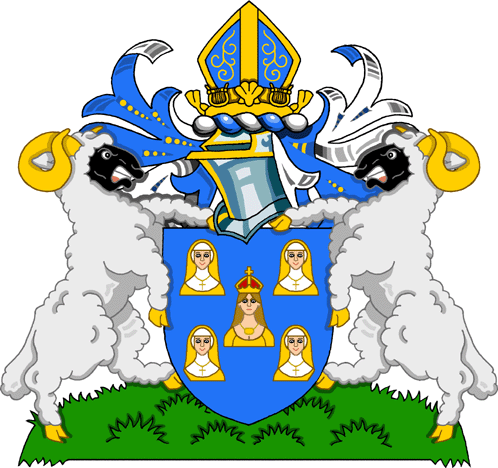 |
 |
||||
|
The coat of arms of Reading was granted to the Reading Corporation in 1566 and the crest, supporters and motto added on 20th May 1953. Heraldically, they are described as follows:
The emblem of five heads cut off at the neck displayed in the form of a St. Andrew's cross, the central one being crowned, had been used by the Reading Merchant Guild on the town's common seal as early as 1365. However, in these early depictions, the five busts are those of men with short bob haircuts. The king in the centre wears a 'Saxon' style crown. The five have long been locally associated with the old legend of the late 10th century Queen Elfrida (more properly spelt Aelfthryth)'s murder of her step-son, King Edward the Martyr. They may originally have represented King Edward and four of his hunting companions. In 1566, an heraldic shield was formally granted to the Corporation by the College of Arms and it was at this time that the men were transformed into ladies. A large golden 'RE' was also added, one letter either side of the central queen. It seems likely that this stood for 'Regina Elizabetha' (Queen Elizabeth) and was supposed to be a mere temporary appendage, given in honour of Queen Elizabeth I who spent much time resident at the Palace of Abbey House in the town. A second grant in 1623 did not include the 'RE' but it was officially reinstated in 1953. The 'maidens' are supposed to represent Queen Elfrida and her ladies-in-waiting, although they are shown as nuns in the illustration arms due to their story: Once upon a time, there was a good and popular King of England called Edgar the Peacemaker. He had one weakness, and that was women. Despite her wickedness but because of her extreme beauty, he married, as his third wife, the Lady Elfreda. The mitre crest, of course, remembers the rare honour bestowed upon the Abbots of Reading of being able to wear the mitre usually reserved for bishops. The scallop shells were the cost-effective badges of medieval pilgrims, particularly associated with St. James, for they were gathered on the beach near his Shrine at Compostella (Spain) from where his hand eventually made its way to Reading. The lyres remember Reading Abbey's musical reputation, having been the place were on e of the oldest pieces of English music was written down. The sheep supporters, of course, represent reading's place at the centre of the medieval and Tudor wool industry. They are here illustrated as Berkshire Knot Wethers. The portcullis is for the borough and the double streams of water for the Rivers Kennet & Thames. See the original grants of arms on the Berkshire Record Office Website
|
||||
| © Nash Ford Publishing 2017. All Rights Reserved. | |||||





